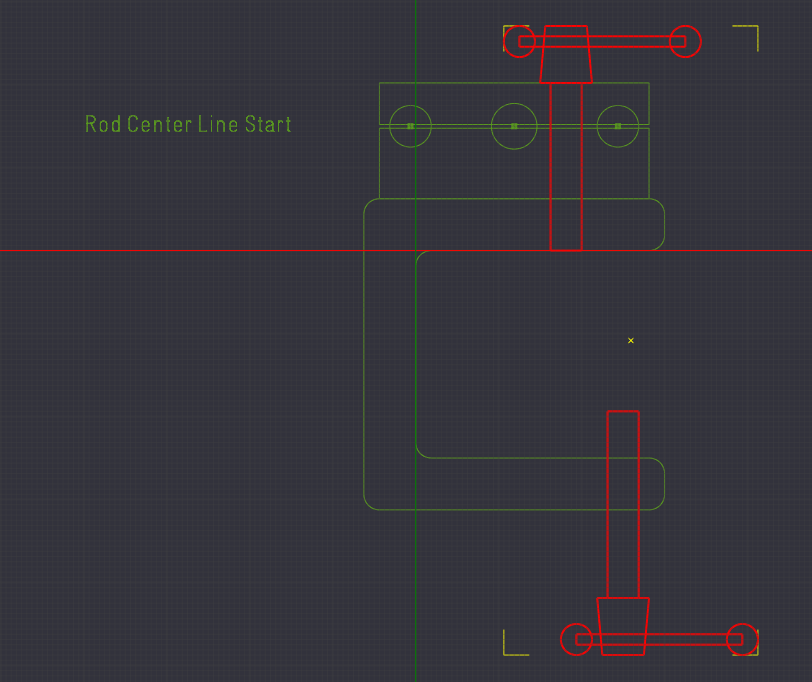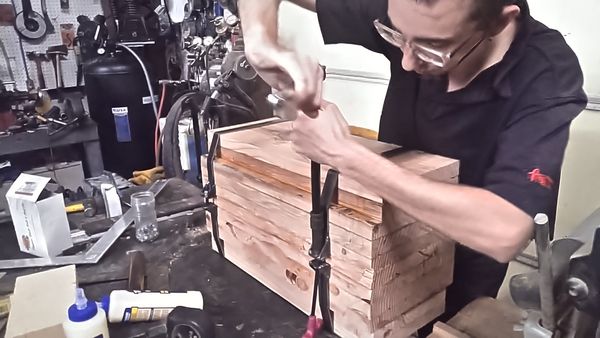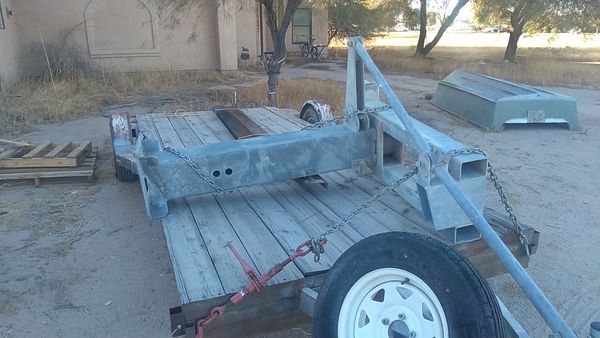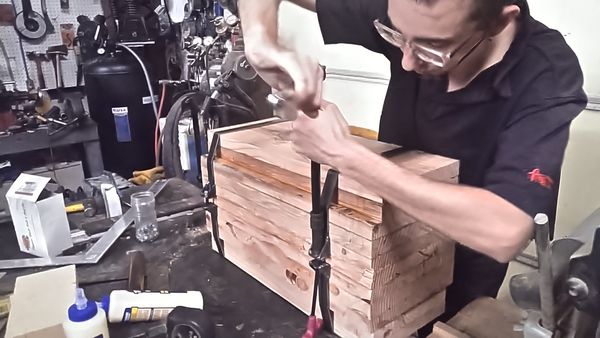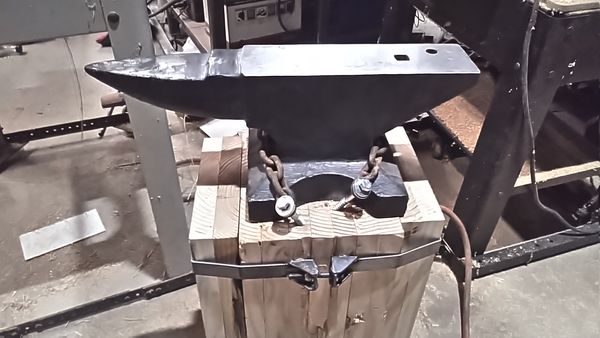
Bob La londe
Members-
Posts
13 -
Joined
-
Last visited
Content Type
Profiles
Forums
Articles
Gallery
Downloads
Events
Everything posted by Bob La londe
-
6061 - Casting
Bob La londe replied to Bob La londe's topic in Smelting, Melting, Foundry, and Casting
If only I had the time to play... Been so busy machining parts. Right now I'm work on a 50 mold (100 parts) wholesale order, and there are a dozen custom jobs waiting. On the other hand there is a lot more 6061 scrap in the shop to play with. LOL. My son has a steady girlfriend now (he even invited her for Thanksgiving dinner), and its hard to get him to help in the shop. He's working on pharmacy tech license, still working on his engineering degree, and of course working, so I can't begrudge him wanting to hang with his girl instead of his dad. I did get him to haul a bunch of plywood upstairs in the shop for some shelves I want to build up there the other day. -
Old threads like this are awesome. Found just what I needed. I'm making a vise handle for a float lock vise, and I would prefer to forge a ball on the end of the handle for the main vise. That being said I have 1018, 1144, and 304 stainless in just the right size for the application. I knew 1144 was the strongest of the three, but I didn't know about its forgeability. I also have 1045, and 4140 on hand, but none in a size that would not require me to turn them down first. Now I'm pretty sure I can lop off a piece of 1144 and ball the ends with little issue. Thanks for this old post guys. I was concerned because of 1144s reputation for not being generally weldable as to how well it would forge. P.S. Stressproof and Fautigeproof are tradenames. I believe they are registered trademarks. There may be some difference in the two as they are marketed differently. 1144 is a composition with a range of ingredients.
-
What did you do in the shop today?
Bob La londe replied to Mark Ling's topic in Blacksmithing, General Discussion
Today my son and I worked on a slide lock drill press vise build for his Grampa. Tomorrow we hope to finish up the table clamp and deliver it. -
I have been thinking about mounting my little piece of armor plate to be used as a striking anvil. Its a little thin (IMO) at only 1 inch, but its been used for metal beating for a lot more years than I've had it. A friend of mine gave it to me years ago, and his dad had used it for metal beating for years before that. My biggest concern is how best to mount it. Welding AR500 is not all that difficult if you do it right, but it will loose a lot of its hardness around the welds if I weld on mounting ears. I've got a couple packs of nickle 55 rod that should weld it nicely, or with more care in heat management I could use some E7018.
-
6061 - Casting
Bob La londe replied to Bob La londe's topic in Smelting, Melting, Foundry, and Casting
I was just chatting with Gary over on the CamBam forum and he confirmed something for me. I had found an old post he had made on the subject where he talked about how much aluminum and silicon he had used to make some castings. I quickly did the math and he only added about 4% silicon. That brings 6061 upto about 4.4%. 356 as I mentioned earlier is 6.5-7.5% I asked how it poured and he said he only used 4% because he only had a pound of silicon and was saving some just in case, but his 4% add poured as good as he hoped for. I don't know what that means metallurgically, but that may be good news economically. If I can get good castings with just 4% added that's a big deal. Silicon metal is expensive. Not like gold expensive of course, but for general use and playing expensive. Around $10/lb. More for just a couple pounds. A little less for 20+lbs. I also ran across some references to using ferrosilicon alloy. I need to read more on that because actual 356 does have some iron as well. My goal would be a casting with good machinability. -
LOL-IRL No. Not really. Like I said my "anvil" for ages was a piece of AR500 armor plate. Bought what I thought was a steel anvil a few years, and found it to be pretty soft and spark tested like cast iron. I guessed I was correct when I complained and the seller gave me my money back AND told me to keep the anvil. It was not cast iron priced. Its been shuffled around the work benches and floor for several years, but never been used. Finally when my son expressed an interest I told him to build a board stump and mount it figuring it would deform and self destruct over time, but since we had it might as well use it. I have been rather surprised at how much nicer it is to use than my piece of armor plate. Maybe just because its about 70lbs and mounted and the piece of armor plate is unmounted and 25-30 pounds. Oh, I can see it deforming, but not quite as badly as I expected.
-
First off, accept for the the clearly whimsical reference to the Acme anvil, rocket, and explosives company I did not specify London pattern. Second there are lots of types of cast iron. If you can forge metal on it is it still ok to scream ASO at cast iron? I guess for some it is. If you can forge metal on it its an anvil. Your reference to rocks and cobble stones backs this up. You had one you didn't like because you had something better before. Got it. I guess lastly (for now) there seems to be some gross misapprehension that everybody lives or works just down the street from a scrap yard that sells cheap to individuals or a machine shop that gives away medium carbon or tool steel drops to anybody who walks in with a smile and a box of donuts. If you have to buy that block of steel somebody else just lucked into for free its not so cheap. Ok... its not totally luck if you go looking for it, but its still lucky if you live next door to that ideal machine shop or scrap yard. FYI: For years I used a piece of AR500 armor plate for my occasional heating and beating session. Worked fine.
-
I have a question that I think might set off or trigger a few people, but I kind of need to ask. When I talk about bias: I'm not talking about the percentage of horn vs percentage of weight or any variant of that bias. I'm not talking about Acme anvils always landing on the coyote and never on the road runner. I'm talking about anvil materials. There is a very strong bias in many groups against cast iron anvils. Basically the term anvil shaped object was coined to disparage them. I have to ask. Weren't all early ferrous anvils cast iron for the first thousand years or so? Heck, weren't tree stumps themselves used as anvils when necessary? Sure I get it. A cast steel anvil is better than a cast iron anvil, and a forged steel anvil is generally better than a cast steel anvil, but why is it necessary to be so biased about it. Can't you make anything you need on a cast iron anvil? Especially if you are a dilettante or a occasional hobbyist? Couldn't a skilled smith beat out anything he/she needed on a suitable tree stump? If you are one of those who say "forge steel or nothing" does that mean you can't work on anything else? Yes I know this could be an incendiary topic, but I am hoping the responses will be more thoughtful than that. I wonder sometimes if it isn't an instinctive barrier to entry used by some. Big companies that dominate an industry (near monopoly power) like deregulation as it increases profitability, but they like a certain amount of licensing and regulation if it applies to everybody no matter how small because it acts as a barrier to entry to small competitors and startups who can otherwise produce leaner and often faster than they can. P.S. If this is a taboo subject because of past flame wars or other such nonsense feel free to delete. I am curious about thought out responses, but its not my intent to start a riot.
-
Ok, before I get the knee jerk response that 6061 isn't good for casting I actually have something to add to the subject. Well, I think I do. Yes, 6061 as it is is not great for casting, but because of my primary business I generate a lot of scrap 6061. The first solution I found is maybe beyond the average backyard metal caster. Its pressure die casting and fast cooling. You still have to make some allowances in your design for shrinkage and what not because you are making a molten metal solid, but it doesn't allow for the grain structure formation that seems to make 6061 less suitable for casting. Its an industrial process and take a little more than most people are willing to do, but I saw it as a possibility. Not one I would likely do because of the work or capital (or a little of both involved), but a possibility. I'm not an expert on the subject by any means. I've just read a couple articles on it and a few published research papers that touch on it. The steel dies would not be horrible for me to make. Its the whole pressure casting setup that is a bit more involved. The other one was a bit of a surprise. I posted in a machining group to give away a bunch of small bits to somebody who could use them for their hobby machining projects. I sent off a stuffed full padded flat mail envelope (not even a noticeable dent in my scrap piles) of small blocks. A few days later a fellow by the monicker of Gary H Lucas said he considered those to be melty bits. I run into Gary on various forums and he's usually not full of horse pucky, so I explained that those were 6061 and generally not accepted to be great for metal casting. Yep. He agreed and then explained he adds a small amount of silicon metal and it then pours a lot like 356. 356 aluminum is one of the most common cast aluminum alloys. It or proprietary blends that are suspiciously similar are used for engine blocks, heads, light machine tables, and a host of other applications. I have some remelted alloy ingots on hand that came from engine blocks melted in another small foundry. Now I have not tried it yet, but I did order 22 lbs of elemental silicon chunks. I will be trying it eventually. If I can recycle most of my scrap 6061 it will be awesome. Silicon is not cheap, but proper 356 alloy ingots aren't either. After I ordered the silicon (not here yet) I decided to look up the milting point of silicon metal. Wow. Its a lot hotter than aluminum. 2577F Beyond the heat range of the furnace I am building. Actually converting some of the parts of a pottery kiln to my own setup with PID controls. So, I went on a forum Gary hangs out on regularly and asked him about alloying the silicon with the aluminum. He claimed it was melted in at his regular 1100F aluminum pouring temperature. I guess that could happen. There are other metals that "blend" at lower than their melting point. If it all works I'll report back. If you have more knowledge on this please feel free to pile on. From what I understand it wouldn't be good for the mountains of chips I generate due to the percentage of it that is oxidized aluminum (the skin on all aluminum exposed to air), but it would be nice to not shovel all those drops, and bad cuts into the recycle bin.
-
Show me your anvil stands
Bob La londe replied to pkrankow's topic in Stands for Anvils, Swage Blocks, etc
-
If you have something to use as a fulcrum (fiber glass ladder, taller stump, strong enough saw horse etc) you could use a wood beam (or something else you might have) and the rope you have with several wraps, add weight to the long end, and do some math. Probably won't get you to the pound, but might get you within 10 or 20. Atleast within 50. LOL. Oh, duh. I see Glenn already said that.
-
First off, Glen, Thanks for the assist. Frosty I didn't get your message. Just the email notification. I'm not a black smith and I don't plan for it to be a primary part of my business or hobby life. I do some crude metal beating mostly using a rosebud on the OA torch as needed, because sometimes its the fastest easiest way to get a step closer to the part or tool I am making. Blacksmithing or more accurately heat and beating is just one of many tools in the old arsenal. Yes I have an anvil (cast iron although it was sold as forged steel - long story). Yes I have a two burner propane forge. Both get shuffled into a corner or set on a shelf most of the time until they are needed. The main reason I have gotten more interested is because my son (mid 20s) has developed a passing interest and there aren't that many things we do together any more. He's a gamer, 3D printer, miniature painter, college student, and courtesy clerk at a store. I'm mostly a CNC machinist and sport angler. Most of the time when we do things its because I told him I need a hand with something, and helping the ol' man is what you do when he asks. Just like helping the kid is what you do when he asks. I was rather surprised when he showed enough of an interest to build a glue, pin, and steel strap stump out of old dry 2x12s for our little 70lb cast iron anvil. Ok. I helped. A little. We haven't done a whole lot of actual heating and beating, but we have made the obligatory leaf, a few failed tongs, a couple successful tongs, and just beat on some metal to see what it does with different hammer techniques. Pretty much using one of my 3lb engineers hammers. He says its to heavy for him to work for very long and he wants a power hammer. Not happening real soon, but I did pick up a large piece of scrapped commercial TVRO dish mount that looks like it will make 90% of the fixed steel for one. At $20 bucks I couldn't pass it up for the steel even if it doesn't work out. I did pick up a few Christmas presents that might be useful though. Mostly I am a CNC machinist (I make low pressure injection molds and low temp casting molds mostly, but other things wander into the shop from time to time), and previously spent 23 years as a license communication contractor. Over the years I've accumulated other tools as I can afford them Several welders, a nice Tinsmith brake, a couple lathes, at least a dozen ways to cut metal, and of course a few CNC mills. Some picture for their entertainment value. I have since ground the horn round on that little metal beating platform. Bob La Londe Fledgling Metal Beater Yuma, Az I do have some ideas for making press dies to make some tools faster and easier. When the only tool you have is a hammer... When your favorite tool is a CNC mill...
